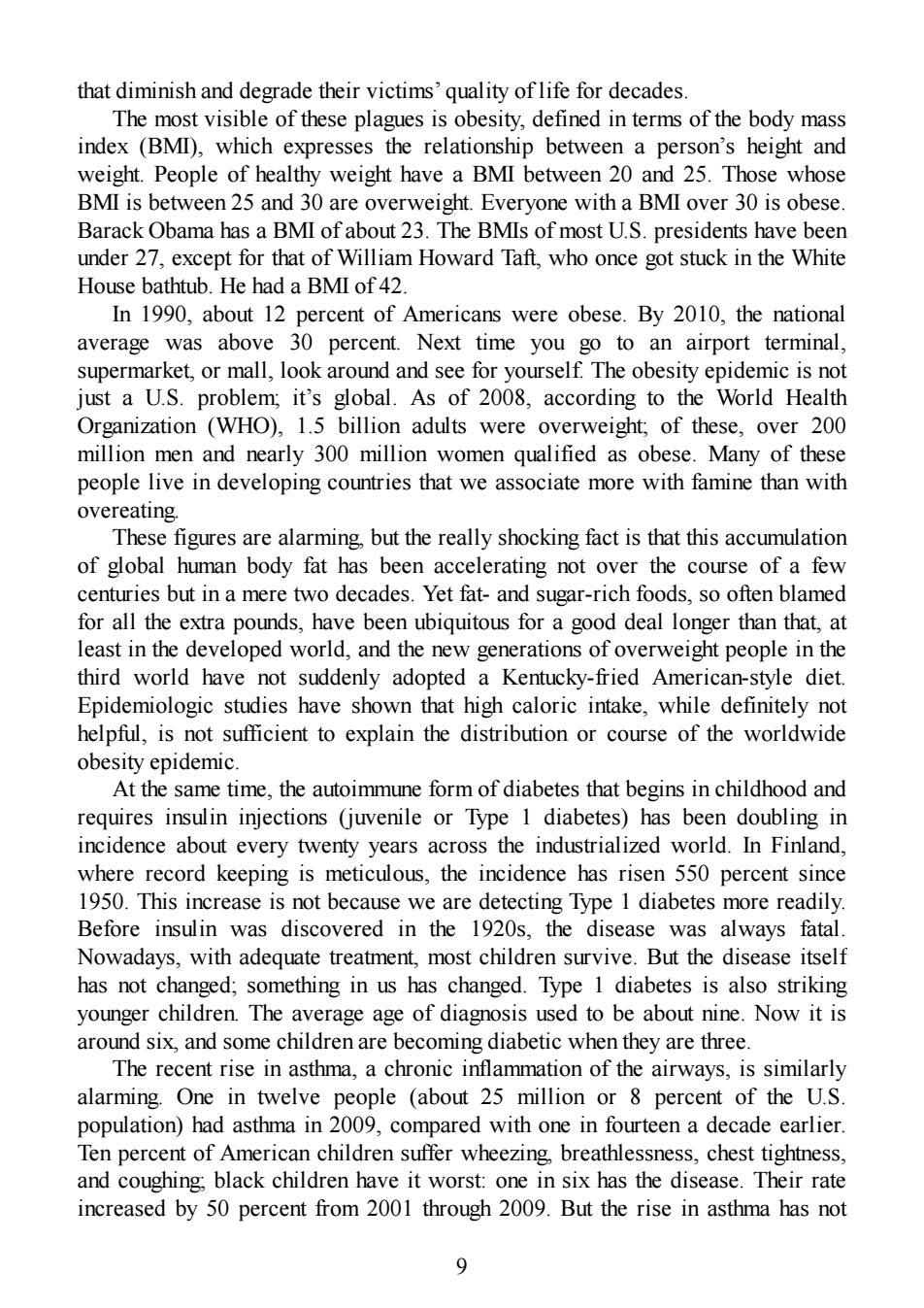正在加载图片...

that diminish and degrade their victims'quality of life for decades. The most visible of these plagues is obesity,defined in terms of the body mass index (BMI).which expresses the relationship between a person's height and weight.People of healthy weight have a BMI between 20 and 25.Those whose BMI is between 25 and 30 are overweight.Everyone with a BMI over 30 is obese Barack Obama has a BMI of about 23.The BMIs of most U.S.presidents have been under 27,except for that of William Howard Taft,who once got stuck in the White House bathtub.He had a BMI of 42. In 1990,about 12 percent of Americans were obese.By 2010,the national average was above 30 percent.Next time you go to an airport terminal, supermarket,or mall,look around and seefor yourself The obesity epidemic is not just a U.S.problem;it's global.As of 2008,according to the World Health Organization (WHO),1.5 billion adults were overweight;of these,over 200 million men and nearly 300 million women qualified as obese.Many of these people live in developing countries that we associate more with famine than with overeating These figures are alarming but the really shocking fact is that this accumulation of global human body fat has been accelerating not over the course of a few centuries but in a mere two decades.Yet fat-and sugar-rich foods,so often blamed for all the extra pounds,have been ubiquitous for a good deal longer than that,at least in the developed world,and the new generations of overweight people in the third world have not suddenly adopted a Kentucky-fried American-style diet. Epidemiologic studies have shown that high caloric intake,while definitely not helpful,is not sufficient to explain the distribution or course of the worldwide obesity epidemic At the same time,the autoimmune form of diabetes that begins in childhood and requires insulin injections (juvenile or Type 1 diabetes)has been doubling in incidence about every twenty years across the industrialized world.In Finland. where record keeping is meticulous,the incidence has risen 550 percent since 1950.This increase is not because we are detecting Type 1 diabetes more readily Before insulin was discovered in the 1920s,the disease was always fatal Nowadays,with adequate treatment,most children survive.But the disease itself has not changed;something in us has changed.Type 1 diabetes is also striking younger children.The average age of diagnosis used to be about nine.Now it is around six.and some children are becoming diabetic when they are three The recent rise in asthma,a chronic inflammation of the airways,is similarly alarming.One in twelve people (about 25 million or 8 percent of the U.S. population)had asthma in 2009 compared with one in fourteena decade earlier. Ten percent of American children suffer wheezing,breathlessness,chest tightness, and coughing,black children have it worst:one in six has the disease.Their rate increased by 50 percent from 2001 through 2009.But the rise in asthma has not that diminish and degrade their victims’ quality of life for decades. The most visible of these plagues is obesity, defined in terms of the body mass index (BMI), which expresses the relationship between a person’s height and weight. People of healthy weight have a BMI between 20 and 25. Those whose BMI is between 25 and 30 are overweight. Everyone with a BMI over 30 is obese. Barack Obama has a BMI of about 23. The BMIs of most U.S. presidents have been under 27, except for that of William Howard Taft, who once got stuck in the White House bathtub. He had a BMI of 42. In 1990, about 12 percent of Americans were obese. By 2010, the national average was above 30 percent. Next time you go to an airport terminal, supermarket, or mall, look around and see for yourself. The obesity epidemic is not just a U.S. problem; it’s global. As of 2008, according to the World Health Organization (WHO), 1.5 billion adults were overweight; of these, over 200 million men and nearly 300 million women qualified as obese. Many of these people live in developing countries that we associate more with famine than with overeating. These figures are alarming, but the really shocking fact is that this accumulation of global human body fat has been accelerating not over the course of a few centuries but in a mere two decades. Yet fat- and sugar-rich foods, so often blamed for all the extra pounds, have been ubiquitous for a good deal longer than that, at least in the developed world, and the new generations of overweight people in the third world have not suddenly adopted a Kentucky-fried American-style diet. Epidemiologic studies have shown that high caloric intake, while definitely not helpful, is not sufficient to explain the distribution or course of the worldwide obesity epidemic. At the same time, the autoimmune form of diabetes that begins in childhood and requires insulin injections (juvenile or Type 1 diabetes) has been doubling in incidence about every twenty years across the industrialized world. In Finland, where record keeping is meticulous, the incidence has risen 550 percent since 1950. This increase is not because we are detecting Type 1 diabetes more readily. Before insulin was discovered in the 1920s, the disease was always fatal. Nowadays, with adequate treatment, most children survive. But the disease itself has not changed; something in us has changed. Type 1 diabetes is also striking younger children. The average age of diagnosis used to be about nine. Now it is around six, and some children are becoming diabetic when they are three. The recent rise in asthma, a chronic inflammation of the airways, is similarly alarming. One in twelve people (about 25 million or 8 percent of the U.S. population) had asthma in 2009, compared with one in fourteen a decade earlier. Ten percent of American children suffer wheezing, breathlessness, chest tightness, and coughing; black children have it worst: one in six has the disease. Their rate increased by 50 percent from 2001 through 2009. But the rise in asthma has not 9